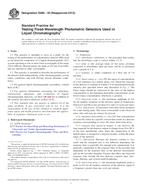Potřebujeme váš souhlas k využití jednotlivých dat, aby se vám mimo jiné mohly ukazovat informace týkající se vašich zájmů. Souhlas udělíte kliknutím na tlačítko „OK“.
ASTM E2387-05(2011)
Standard Practice for Goniometric Optical Scatter Measurements
Automaticky přeložený název:
Standardní praktiky pro goniometrické optického rozptylu měření
NORMA vydána dne 1.7.2011
Informace o normě:
Označení normy: ASTM E2387-05(2011)
Poznámka: NEPLATNÁ
Datum vydání normy: 1.7.2011
Kód zboží: NS-45195
Počet stran: 14
Přibližná hmotnost: 42 g (0.09 liber)
Země: Americká technická norma
Kategorie: Technické normy ASTM
Kategorie - podobné normy:
Anotace textu normy ASTM E2387-05(2011) :
Keywords:
bidirectional reflectance distribution function (BRDF), bidirectional scatter distribution function (BSDF), bidirectional transmittance distribution function (BTDF), diffuse, irradiance, radiance, scatter, specular, ICS Number Code 17.180.30 (Optical measuring instruments)
Doplňující informace
| Significance and Use | ||||||||||
|
The angular distribution of scatter is a property of surfaces that may have direct consequences on an intermediate or final application of that surface. Scatter defines many visual appearance attributes of materials, and specification of the distribution and wavelength dependence is critical to the marketability of consumer products, such as automobiles, cosmetics, and electronics. Optically diffusive materials are used in information display applications to spread light from display elements to the viewer, and the performance of such displays relies on specification of the distribution of scatter. Stray-light reduction elements, such as baffles and walls, rely on absorbing coatings that have low diffuse reflectances. Scatter from mirrors, lenses, filters, windows, and other components can limit resolution and contrast in optical systems, such as telescopes, ring laser gyros, and microscopes. The microstructure associated with a material affects the angular distribution of scatter, and specific properties can often be inferred from measurements of that scatter. For example, roughness, material inhomogeneity, and particles on smooth surfaces contribute to optical scatter, and optical scatter can be used to detect the presence of such defects. The angular distribution of scattered light can be used to simulate or render the appearance of materials. Quality of rendering relies heavily upon accurate measurement of the light scattering properties of the materials being rendered. |
||||||||||
| 1. Scope | ||||||||||
| p>1.1 This practice describes procedures for determining the
amount and angular distribution of optical scatter from a surface.
In particular it focuses on measurement of the bidirectional
scattering distribution function (BSDF). BSDF is a convenient and
well accepted means of expressing optical scatter levels for many
purposes. It is often referred to as the bidirectional reflectance
distribution function (BRDF) when considering reflective scatter or
the bidirectional transmittance distribution function (BTDF) when
considering transmissive scatter.
1.2 The BSDF is a fundamental description of the appearance of a sample, and many other appearance attributes (such as gloss, haze, and color) can be represented in terms of integrals of the BSDF over specific geometric and spectral conditions. 1.3 This practice also presents alternative ways of presenting angle-resolved optical scatter results, including directional reflectance factor, directional transmittance factor, and differential scattering function. 1.4 This practice applies to BSDF measurements on opaque, translucent, or transparent samples. 1.5 The wavelengths for which this practice applies include the ultraviolet, visible, and infrared regions. Difficulty in obtaining appropriate sources, detectors, and low scatter optics complicates its practical application at wavelengths less than about 0.2 m (200 nm). Diffraction effects start to become important for wavelengths greater than 15 m (15 000 nm), which complicate its practical application at longer wavelengths. Measurements pertaining to visual appearance are restricted to the visible wavelength region. 1.6 This practice does not apply to materials exhibiting significant fluorescence. 1.7 This practice applies to flat or curved samples of arbitrary shape. However, only a flat sample is addressed in the discussion and examples. It is the users responsibility to define an appropriate sample coordinate system to specify the measurement location on the sample surface and appropriate beam properties for samples that are not flat. 1.8 This practice does not provide a method for ascribing the measured BSDF to any scattering mechanism or source. 1.9 This practice does not provide a method to extrapolate data from one wavelength, scattering geometry, sample location, or polarization to any other wavelength, scattering geometry, sample location, or polarization. The user must make measurements at the wavelengths, scattering geometries, sample locations, and polarizations that are of interest to his or her application. 1.10 Any parameter can be varied in a measurement sequence. Parameters that remain constant during a measurement sequence are reported as either header information in the tabulated data set or in an associated document. 1.11 The apparatus and measurement procedure are generic, so that specific instruments are neither excluded nor implied in the use of this practice. 1.12 For measurements performed for the semiconductor industry, the operator should consult Practice SEMI ME 1392. This standard does not purport to address all of the safety concerns, if any, associated with its use. It is the responsibility of the user of this standard to establish appropriate safety and health practices and determine the applicability of regulatory limitations prior to use. |
||||||||||
| 2. Referenced Documents | ||||||||||
|
Podobné normy:
Historická
1.10.2009
Historická
1.5.2008
Historická
1.5.2013
Historická
1.11.2011
Historická
1.1.2013
Historická
1.1.2013
Odebírejte informace o nově vydaných normách ZDARMA:
Chcete pravidelně odebírat informace o nově vycházejících normách z celého světa a to zcela zdarma?
Přihlašte se k odběru. Vše je velice jednoduché a absolutně ZDARMA.
Na výběr máte vydavatele z celého světa.



 ASTM E388-04(2009)..
ASTM E388-04(2009).. ASTM E520-08
ASTM E520-08 ASTM E578-07(2013)..
ASTM E578-07(2013).. ASTM E594-96(2011)..
ASTM E594-96(2011).. ASTM E685-93(2013)..
ASTM E685-93(2013).. ASTM E840-95(2013)..
ASTM E840-95(2013)..
 Cookies
Cookies
